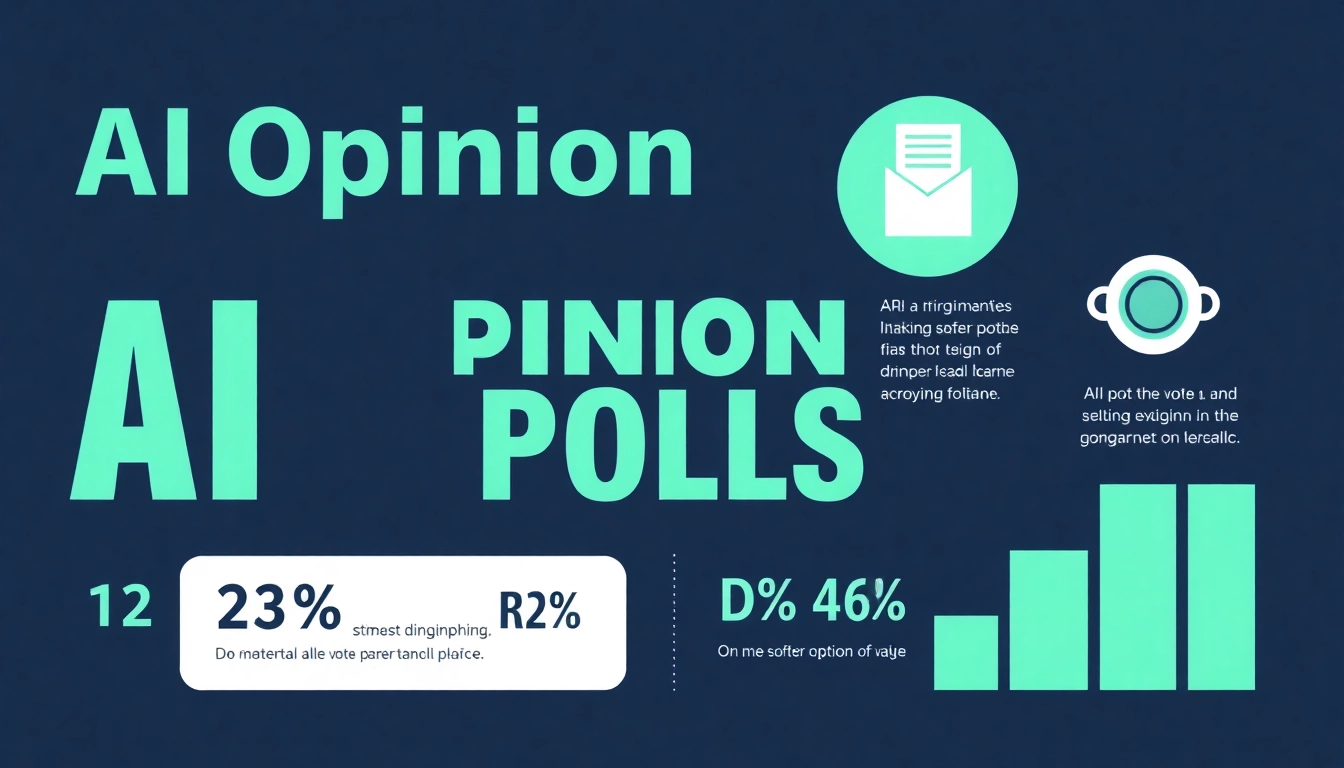1. Overview of AI Opinion Polls
1.1 What is an AI Opinion Poll?
An AI opinion poll is a systematic survey tool designed to gather insights about public sentiments regarding artificial intelligence technologies and their impact on society. This type of polling utilizes artificial intelligence algorithms to analyze trends and opinions from diverse demographics, offering a nuanced understanding of how people view AI. AI opinion polls can be conducted through various methods, including online surveys and social media analysis, both of which can efficiently aggregate data and provide real-time feedback on public attitudes.
1.2 Importance of AI in Modern Polling
The integration of AI into polling methodologies has transformed how data is collected and interpreted. By leveraging advanced machine learning algorithms, organizations can process vast amounts of information quickly, reducing the time and cost associated with traditional opinion polling methods. With the ability to analyze sentiment from social media, news articles, and public forums, AI significantly enhances the depth and accuracy of the insights gained. This is especially crucial as public perceptions of AI evolve rapidly, reflecting both excitement and apprehension surrounding its capabilities.
1.3 Key Statistics and Trends
Recent surveys indicate a growing divide in public opinion regarding AI technologies. For instance, a AI Opinion poll conducted by Gallup shows that many respondents express more concern than enthusiasm about AI, with a notable percentage believing it poses risks to employment and privacy. Additionally, a Pew Research study from November 2023 indicated that 52% of Americans are more concerned than excited about AI’s role in daily life, signaling a trend where the potential benefits of AI are often outweighed by fears of misuse and unintended consequences.
2. Public Perception of AI Technologies
2.1 General Attitudes Toward AI
Public attitudes towards AI are complex and often contradictory. While many consumers acknowledge the convenience and efficiency brought by AI technologies, a significant portion remains skeptical. For instance, AI’s ability to handle menial tasks seamlessly has led to increased productivity in sectors like customer service and e-commerce. However, this advancement raises alarms about possible job displacement, leading some to advocate for stringent regulations on AI usage. The challenge lies in balancing innovation with ethical considerations, ensuring AI development aligns with public interests.
2.2 Concerns vs. Benefits of AI Usage
The debate over AI’s pros and cons is at the forefront of public discourse. On one hand, proponents highlight AI’s capability to process large datasets, leading to breakthroughs in healthcare, finance, and research. For example, AI technologies are applied in predictive analytics to enhance patient outcomes and streamline administrative processes. Conversely, many express concerns over privacy violations, data security, and the ethical implications of decision-making by AI systems. The critical task for policymakers and technologists is to address these concerns pragmatically while continuing to promote AI’s benefits.
2.3 Case Studies: AI in Everyday Life
Real-world implementations of AI highlight its multifaceted roles in everyday life. For instance, virtual assistants like Amazon’s Alexa and Google Assistant have become ubiquitous, simplifying tasks like setting reminders or controlling smart home devices. However, a study indicated that while nearly all Americans use AI technologies, many are unaware of their presence in everyday applications. This disconnect can undermine trust and acceptance of AI, as people are often apprehensive about technologies they don’t fully understand. Organizations must work to increase public awareness, showcasing transparency in AI functionalities to build trust.
3. Factors Influencing AI Opinions
3.1 Demographics and AI Perceptions
Demographic factors significantly influence public opinion on AI. Age, education level, and geographic location all shape how individuals perceive the benefits and risks associated with AI technologies. Younger generations, typically more tech-savvy, are generally more optimistic about AI’s potential, whereas older demographics often approach AI with caution, focusing on its implications for job security. Understanding these demographic nuances is crucial for tailoring communication strategies that resonate with diverse audiences.
3.2 Media Influence on Public Opinion
Media plays a pivotal role in shaping public perceptions of AI. News outlets, social media platforms, and influential personalities contribute to the dominant narratives surrounding AI, either fostering enthusiasm or amplifying fears. For example, sensationalized reporting on data breaches involving AI systems can fuel public anxiety, while articles highlighting the positive impact of AI in healthcare can inspire hope. As such, responsible reporting and balanced coverage are essential for promoting informed discussions about AI technologies.
3.3 Cultural Differences in AI Acceptance
Cultural factors also dictate how societies perceive AI. In regions such as Scandinavia, high trust in technology and strong welfare systems facilitate a more favorable outlook on AI, with many viewing it as an opportunity for societal advancement. Conversely, countries with a historical skepticism of technological change may experience greater resistance to AI adoption. Tailoring AI deployment strategies to align with cultural values can enhance acceptance and efficacy, making it vital for global tech firms to consider these differences when entering new markets.
4. Analyzing AI Opinion Poll Results
4.1 Methodologies Used in Polling
AI opinion polls utilize various methodologies that blend traditional polling techniques with advanced algorithmic approaches. Online surveys, focus groups, and sentiment analysis of social media can all contribute to a comprehensive understanding of public sentiment. Furthermore, AI technologies can streamline the interpretation of complex data sets, identifying trends that might not be immediately evident through standard analysis. The use of natural language processing (NLP) techniques, for instance, allows researchers to gauge public sentiment by analyzing the language used in online discussions about AI.
4.2 Common Misconceptions Addressed
Despite significant advancements in AI research and applications, misconceptions abound that can skew public perception. One prevalent myth is the belief that AI will entirely replace human jobs. Research shows that while AI can automate certain tasks, it also creates new employment opportunities that require skills in technology management and oversight. Educating the public on the collaborative potential of AI—as a tool that augments rather than replaces human capabilities—can help mitigate fears and foster more positive attitudes towards AI technologies.
4.3 The Role of AI in Shaping Future Polls
The future of opinion polling will likely be heavily influenced by advancements in AI technology. As AI systems continue to evolve, their ability to synthesize and analyze opinion data will improve, allowing for faster and more nuanced insights. Additionally, AI could facilitate more targeted surveys, reaching specific demographics based on detailed segmentation. This targeted approach can yield richer data, helping organizations better understand public sentiment and develop strategies that align with prevailing attitudes.
5. Future Directions and Recommendations
5.1 Enhancing AI Opinion Poll Processes
To improve the efficacy of AI opinion polls, organizations should invest in refining their methodologies. Incorporating multi-channel data collection strategies that leverage online input while ensuring traditional outreach methodologies, like phone surveys, are also employed can yield more representative samples. Furthermore, utilizing AI to analyze open-ended survey responses can provide rich qualitative insights that quantitative methods might overlook, enhancing the overall understanding of public sentiment towards AI.
5.2 Engaging the Public in AI Discussions
Proactive engagement of the public in discussions about AI is crucial. Creating forums for open dialogue—ranging from community workshops to interactive online platforms—can help demystify AI technology and its implications. Organizations should aim to include a broader spectrum of voices in these discussions, including those from underrepresented communities, to ensure a holistic understanding of societal attitudes toward AI.
5.3 The Role of Stakeholders in AI Policy Making
Stakeholders—including government agencies, private companies, and civic organizations—must collaborate to establish policies that promote the responsible use of AI technologies. This collaboration can address public concerns while facilitating innovation. By bringing together diverse expertise and perspectives, stakeholders can create guidelines that not only protect public interests but also encourage technological advancements.


